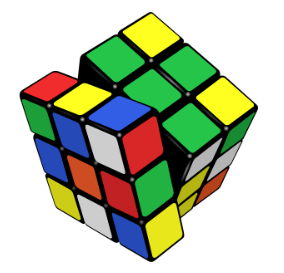The Way bears one.
The one bears two.
The two bear three.
The three bear the ten thousand things.
-- Tao Te Ching, Chp.42

Picture from wikipedia.
Cube (v.) has some definitions at first, but nobody really cares about them. After Prof. Rubik invented the all-time popular toy named after himself, this verb stood for solving a Rubik's Cube from a scrambled state.
In the broadest sense, cubing is what a cuber does, and it can refer to all kinds of activities related to any kinds of cubes (twisty puzzles). For example, blindfolded is a memorization challenge, in which a cuber first tries to remember the whole status of a scrambled cube, and then solving it without the aid of sight. Other than playing them, enthusiasts of Math (geometry, symmetry, group theory, ...) or Mechanics (how to mod, face-/edge/corner-cut, ...) can be very into this hobby as well.
In the narrowest sense, however, cubing is short for speedcubing, a world-wide sport that requires both cognitive and physical skills with many enthusiasts. This is one of the most popular activities in the WCA (World Cube Association) Championship events.
In this series, cubing refers to the former one. Not only that, most of the time I will just specialize the term as hypercubing.
Hypercubing shares the same spirit as above, despite that hypercubers play with puzzles in higher dimensions. The community maintains a forum at hypercubing google group, where hypercubers discuss mathematics behind high dimensional puzzles, solutions and algorithms, and even physical implementations!
Given that we only have three dimensions in this universe, it is straightforward to assume that it is impossible to create higher-than-3D objects. To some degree, it is true; but you should never underestimate hypercubers. Melinda, the maintainer of
MC4D (the go-to software for 4D hypercubing), has implemented a physical puzzle that is an analogue of a 2x2x2x2 hypercube.
While it is extremely cool to have a physical object that is logically equivalent to a 4D puzzle, 2x2x2x2 (and some cuboids) is a special case. Many other high-dimensional puzzles are still only accessible through the use of simulation software. Other than the previously-mentioned MC4D, there are more like MC5D and MagicTile.
Please allow me to remain mysterious for a while, maybe about 10 days more. It is not hard to guess the meaning of the compound noun, given that now you have a grasp of hypercubing. The hard part is high-dimensional thinking, especially if you never practice it before.
As part I of this series, I will go through some materials (thanks to all those math youtubers out there) in the following few posts. Hopefully I can help you establish some sense on how hypercubing works. After that, part II will consist of my solution to the 2x2x2x2 puzzle in MC4D.
Finally, we will leave the comfort zone of cardinal directions that guides most of the MC4D puzzles, and I will introduce you hyperskewb, a new type of 4D puzzle.
非常簡略地介紹了 cubing 以及子領域的 hypercubing。交待了系列文的走向。
